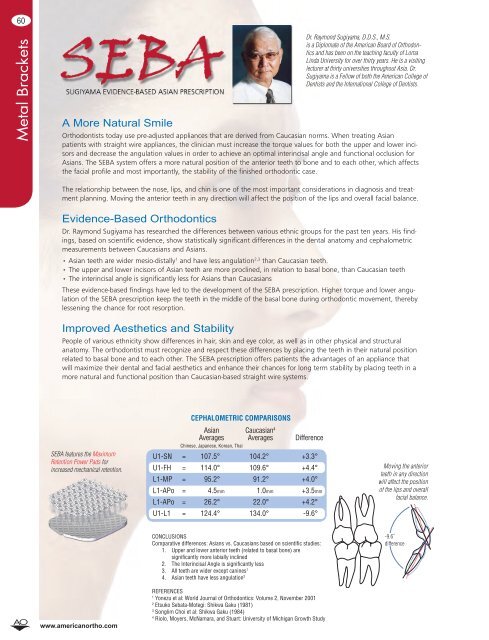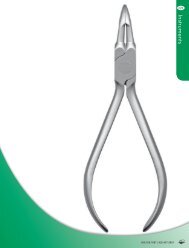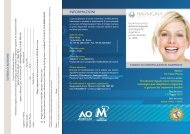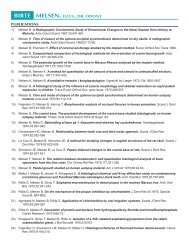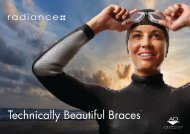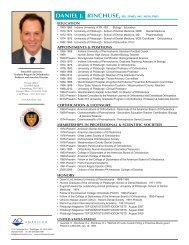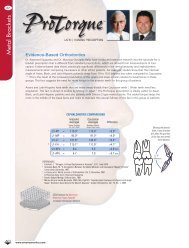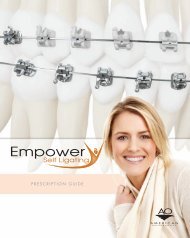Catalog Pages - American Orthodontics
Catalog Pages - American Orthodontics
Catalog Pages - American Orthodontics
You also want an ePaper? Increase the reach of your titles
YUMPU automatically turns print PDFs into web optimized ePapers that Google loves.
60<br />
Metal Brackets<br />
A More Natural Smile<br />
www.americanortho.com<br />
Dr. Raymond Sugiyama, D.D.S., M.S.<br />
is a Diplomate of the <strong>American</strong> Board of <strong>Orthodontics</strong><br />
and has been on the teaching faculty of Loma<br />
Linda University for over thirty years. He is a visiting<br />
lecturer at thirty universities throughout Asia. Dr.<br />
Sugiyama is a Fellow of both the <strong>American</strong> College of<br />
Dentists and the International College of Dentists.<br />
Orthodontists today use pre-adjusted appliances that are derived from Caucasian norms. When treating Asian<br />
patients with straight wire appliances, the clinician must increase the torque values for both the upper and lower incisors<br />
and decrease the angulation values in order to achieve an optimal interincisal angle and functional occlusion for<br />
Asians. The SEBA system offers a more natural position of the anterior teeth to bone and to each other, which affects<br />
the facial profile and most importantly, the stability of the finished orthodontic case.<br />
The relationship between the nose, lips, and chin is one of the most important considerations in diagnosis and treatment<br />
planning. Moving the anterior teeth in any direction will affect the position of the lips and overall facial balance.<br />
Evidence-Based <strong>Orthodontics</strong><br />
Dr. Raymond Sugiyama has researched the differences between various ethnic groups for the past ten years. His findings,<br />
based on scientific evidence, show statistically significant differences in the dental anatomy and cephalometric<br />
measurements between Caucasians and Asians.<br />
• Asian teeth are wider mesio-distally1 and have less angulation2,3 than Caucasian teeth.<br />
• The upper and lower incisors of Asian teeth are more proclined, in relation to basal bone, than Caucasian teeth<br />
• The interincisal angle is significantly less for Asians than Caucasians<br />
These evidence-based findings have led to the development of the SEBA prescription. Higher torque and lower angulation<br />
of the SEBA prescription keep the teeth in the middle of the basal bone during orthodontic movement, thereby<br />
lessening the chance for root resorption.<br />
Improved Aesthetics and Stability<br />
People of various ethnicity show differences in hair, skin and eye color, as well as in other physical and structural<br />
anatomy. The orthodontist must recognize and respect these differences by placing the teeth in their natural position<br />
related to basal bone and to each other. The SEBA prescription offers patients the advantages of an appliance that<br />
will maximize their dental and facial aesthetics and enhance their chances for long term stability by placing teeth in a<br />
more natural and functional position than Caucasian-based straight wire systems.<br />
SEBA features the Maximum<br />
Retention Power Pads for<br />
increased mechanical retention.<br />
CEPHALOMETRIC COMPARISONS<br />
Asian Caucasian4 Averages<br />
Chinese, Japanese, Korean, Thai<br />
Averages Difference<br />
U1-SN = 107.5° 104.2° +3.3°<br />
U1-FH = 114.0° 109.6° +4.4°<br />
L1-MP = 95.2° 91.2° +4.0°<br />
L1-APo = 4.5mm 1.0mm +3.5mm<br />
L1-APo = 26.2° 22.0° +4.2°<br />
U1-L1 = 124.4° 134.0° -9.6°<br />
CONCLUSIONS<br />
Comparative differences: Asians vs. Caucasians based on scientific studies:<br />
1. Upper and lower anterior teeth (related to basal bone) are<br />
significantly more labially inclined<br />
2. The Interincisal Angle is significantly less<br />
3. All teeth are wider except canines 1<br />
4. Asian teeth have less angulation 2<br />
REFERENCES<br />
1 Yonezu et al: World Journal of <strong>Orthodontics</strong>: Volume 2, November 2001<br />
2 Etsuko Sebata-Motegi: Shikwa Gaku (1981)<br />
3 Songlim Choi et al: Shikwa Gaku (1984)<br />
4 Riolo, Moyers, McNamara, and Stuart: University of Michigan Growth Study<br />
Moving the anterior<br />
teeth in any direction<br />
will affect the position<br />
of the lips and overall<br />
facial balance.


